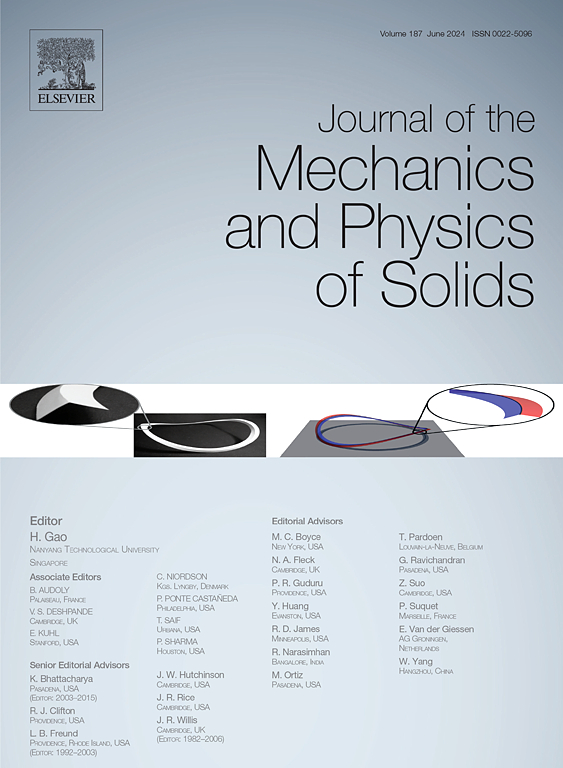Rayleigh-Damköhler流体驱动压裂统一多相场模型
IF 6
2区 工程技术
Q2 MATERIALS SCIENCE, MULTIDISCIPLINARY
引用次数: 0
摘要
在低粘度反应性流体驱动裂缝的地质系统中(例如CO₂压裂),反应性流体从裂缝渗漏到岩石基质中会导致瑞利-泰勒不稳定性,导致手指侵入区域的形成,这些区域会受到化学损伤,从而破坏裂缝的扩展。裂缝扩展与非均质化学损伤密切相关。瑞利数(浮力驱动的对流/扩散)和Damköhler数(化学反应/平流)在很大范围内的显著变化导致了不同的流动和破裂模式。基于虚功原理,提出了一种统一的多相场模型来模拟力学强化化学损伤和溶蚀辅助压裂过程。引入不同的断裂(∅f)和化学损伤(∅d)相场序参数来表征断裂能、化学自由能和溶解界面能。这两个相场通过机械能的协同退化紧密相连。根据自由能和微力平衡的变分公式,推导了Rayleigh-Damköhler流体驱动压裂的控制方程。在此基础上,采用量纲分析方法建立了岩石破坏模式的标度规律。当泄漏流体流量与裂缝扩展方向一致时,利用侵穿长度在相图中识别出区分不同损伤形态的临界曲线。在重力导致漏失流体流动与裂缝方向不一致的情况下,总结归一化裂缝数(Πf)和化学损伤数(Πd),构建包含各种不稳定流体漏失结构和岩石破坏模式的综合相图。本文章由计算机程序翻译,如有差异,请以英文原文为准。
A unified multi-phase-field model for Rayleigh-Damköhler fluid-driven fracturing
In geological systems where fractures are driven by low-viscosity reactive fluids (e.g., CO₂ fracturing), the leak-off of the reactive fluid from fractures into the rock matrix induces Rayleigh-Taylor instability, leading to the formation of fingering invasion regions that undergo chemical damage, thereby destabilizing fracture propagation. The fracture propagation is strongly coupled with the heterogeneous chemical damage. The significant variability of Rayleigh number (buoyancy-driven convection / diffusion) and Damköhler number (chemical reaction / advection) within a wide range causes various flow and fracture patterns. Based on the principle of virtual work, a unified multi-phase-field model is proposed to model the mechanics enhanced chemical damage and dissolution-assisted fracturing process. The distinct fracture () and chemical damage () phase field order parameters are introduced to characterize fracture energy, chemical free energy and dissolution interfacial energy. The two phase fields are tightly linked through a synergistic degradation of mechanical energy. The governing equations for the Rayleigh-Damköhler fluid-driven fracturing are derived from the variational formulation of the free energy and micro-force balance. Based on the model, dimensional analysis is employed to establish the scaling laws for rock failure modes. When leak-off fluid flow aligns with fracture propagation, critical curves distinguishing different damage morphology are identified in the phase diagram using penetration lengths. In scenarios where gravity induces a misalignment between leak-off fluid flow and fracture direction, the normalized fracture number () and chemical damage number () are summarized to construct a comprehensive phase diagram encompassing various unstable fluid leak-off structures and rock failure modes.
求助全文
通过发布文献求助,成功后即可免费获取论文全文。
去求助
来源期刊
CiteScore
9.80
自引率
9.40%
发文量
276
审稿时长
52 days
期刊介绍:
The aim of Journal of The Mechanics and Physics of Solids is to publish research of the highest quality and of lasting significance on the mechanics of solids. The scope is broad, from fundamental concepts in mechanics to the analysis of novel phenomena and applications. Solids are interpreted broadly to include both hard and soft materials as well as natural and synthetic structures. The approach can be theoretical, experimental or computational.This research activity sits within engineering science and the allied areas of applied mathematics, materials science, bio-mechanics, applied physics, and geophysics.
The Journal was founded in 1952 by Rodney Hill, who was its Editor-in-Chief until 1968. The topics of interest to the Journal evolve with developments in the subject but its basic ethos remains the same: to publish research of the highest quality relating to the mechanics of solids. Thus, emphasis is placed on the development of fundamental concepts of mechanics and novel applications of these concepts based on theoretical, experimental or computational approaches, drawing upon the various branches of engineering science and the allied areas within applied mathematics, materials science, structural engineering, applied physics, and geophysics.
The main purpose of the Journal is to foster scientific understanding of the processes of deformation and mechanical failure of all solid materials, both technological and natural, and the connections between these processes and their underlying physical mechanisms. In this sense, the content of the Journal should reflect the current state of the discipline in analysis, experimental observation, and numerical simulation. In the interest of achieving this goal, authors are encouraged to consider the significance of their contributions for the field of mechanics and the implications of their results, in addition to describing the details of their work.

 求助内容:
求助内容: 应助结果提醒方式:
应助结果提醒方式:


